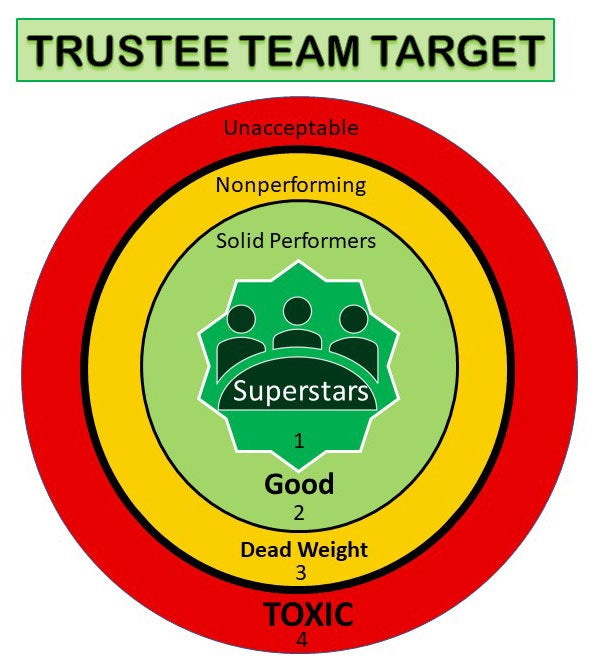
Governance Effectiveness
When a Board Member Crosses the Line: Removing a Trustee Midterm
Addressing problem behaviors is key to a high-performing board
By Jamie Orlikoff
One of the most distasteful — and avoided — tasks faced by any board is the occasional need to remove one of its own members in midterm. While never a pleasant task, it may unfortunately be a necessary one. The ability and willingness to do this must be in a board’s toolbox to create and sustain a governance culture of performance and accountability. To consciously build such a culture, a board must define the desired behaviors of its members, which will help drive the board to its ideal future state of governance. But just as importantly, it also must define board member behaviors that are clearly unacceptable and create a standard process to immediately address them if exhibited by any board member.
A common misconception is that for a board to be truly effective, all members must be high-performing superstars. While that may be the ideal, it is not necessary for effective governance. A board with a robust culture of performance and accountability can function well with a mix of high-performing, good members and a few nonperforming members. But even a single dysfunctional or toxic board member can derail a board’s performance. What is the difference?
Defining Four ‘Circles’ of Board Members
Consider the Trustee Team Target model in Figure 1. It shows four categories of board members arranged in concentric circles. In the innermost circle, or “bull’s-eye,” of the target is the desired state for all board members: the engaged, high-performing members. These are the superstar board members, the ones who do all the reading, attend and thoughtfully participate in all the meetings, who undertake the required and the recommended continuing governance education sessions, who consistently go the extra mile. These are the ones who are passionate learners in service to the mission and the board and consistently rise to the governance occasion. They are team players who place the interests of the organization above their egos. They frequently are the board leaders.
The second circle consists of the good, reasonably performing, solid board members. These are the folks whose hearts are in the right place, who come through when asked, who try to do the work and fulfill the commitments but, even though they have the drive, do not always deliver. They may be new to the board. These are the ones who with thoughtful development can move to the bull’s-eye and become future leaders of the board.
The third circle are the hangers-on, or the “dead weight” board members. They do not do the work, do not show up to all the meetings and do not fully engage in the meetings they do attend. They certainly do not volunteer for extra board work. These are nonperforming board members, but they also do not actively cause problems, sabotage board process, violate confidentiality or work against the board and its culture.
The board members that do that are the occupants of the fourth and outer circle: the dysfunctional, toxic, damaging board members. These are the ones who break the rules of the board, whether explicit or implicit, who sow discord, who pursue their own agendas at the expense of the board and the organization. They seek power for personal gain, violate conflict of interest provisions, breech board confidentiality and undermine board decisions. In short, these are not only bad board members, but they are toxic board members. They prevent effective governance culture and function.
Nipping Board Member Issues in the Bud
Effective boards address nonperforming, third circle members by coaching, peer pressure and if necessary, by not renewing their term based upon an individual performance evaluation process. However, for toxic fourth circle board members, the most effective remedy is to quickly remove them from the board. While unpleasant, this is necessary to prevent ineffective governance, and to enable a board to build and sustain a positive culture of high performance.
When a board allows the toxic, inappropriate behavior of a fourth circle board member to go unchecked, it creates a predictable and worsening negative dynamic. If the board fails to act the first time a board member crosses the line, it sends the unintended message that the behavior is acceptable, which normalizes and enables the toxic behavior. What the board permits, it promotes! Emboldened by the board’s tolerance, the errant board member continues their negative behavior and it likely gets worse.
Other board members recognize this behavior is now “acceptable” or at least tolerated and may then perhaps exhibit similar toxic behaviors. Meanwhile, superstar and good board members may become disheartened and mentally disengage, or even resign, from the board. Or they may remain and try to “work around” the problem board member(s) by creating cliques or board subgroups to further the board’s work without involving the offending board member. The CEO, disturbed at the board’s lack of resolve or ability to address the issue and noting increasing governance dysfunction, may retreat to passivity or seek employment elsewhere. All in all, a terrible situation, and one that a board must prevent or nip in the bud.
Developing Specific Criteria for Board Removal
Boards must create both a specific mechanism and explicit criteria to provide for the removal of a member from the board midterm. The mechanism should be outlined in the bylaws and will describe the process necessary to remove a board member, such as requiring a supermajority vote of the board. Further, it should specify whether a board member can be removed either with or without “cause.”
If a “with cause” bylaws clause is implemented, the board must develop written criteria for when that cause is triggered, and the removal process must be followed. But, even if the bylaws rely only on a “without cause” provision, it is still important for a board to develop specific criteria or threshold behaviors that will trigger a member’s removal from the board. Such criteria are best referred to in the bylaws but maintained in a separate board policy and procedure document that allows revising, updating and fine-tuning the criteria without the need to amend the bylaws.
The full board should be involved in the discussion to develop the set of criteria it considers egregious enough to warrant a board member’s immediate removal. The process of having this crucial governance conversation, with the back-and-forth debate about what the criteria should be, is a key part of developing a high-performance governance culture. Each board is saying “these are our rules, and we take them seriously.” It further makes the boundary of the fourth circle explicit and creates the space to define and move all board members toward the bull’s-eye and create a sustainable governance culture of high performance.
While each board should develop its own criteria, here are common examples of threshold criteria that trigger removal of a member from the board:
- Violating the conflict-of-interest policy, including failure to disclose a conflict.
- Failing to attend a minimum of 50% (or other specified percentage) of board meetings in a one-year period.
- Failing to attend three consecutive board meetings.
- Attempting to use information obtained as a board member in such a way as to derive personal, financial or other benefit.
- Violating the confidentiality policy.
- Verbally abusing board members, staff or patients/families.
- Any physical assault on board members, staff or patients/families at any time, in any place.
- Actively working to subvert stated board policy or decisions.
- Accusation or conviction of felony.
- Improper behavior that brings or risks bringing negative publicity to the hospital.
- Sleeping during board or board committee meetings (two or more instances).
- Speaking against the organization or the board or the CEO or staff in public.
- Racist or sexist comments or behavior.
Developing a process and the criteria for removal of a board member from office will help prevent the need to use it. Board members who know that violating the conflict-of-interest policy will bring about their immediate removal are much less likely to do so. Board members who cannot attend the minimum number of meetings will likely submit their resignations or will rearrange their schedules to fulfill their commitment.
The ideal, high-performing board has all its members snugly in the first circle/bull’s-eye of the target. However, as long as boards have a critical mass of their members in the first and second circles, they can often tolerate a few members in the third, or “nonperforming,” circle and still be high-performing boards. But having a single board member in the outer, fourth circle of toxic or unacceptable behavior corrodes positive governance culture and function. To prevent this, a board must clearly define the line and quickly act when that line is crossed.
Jamie Orlikoff (j.orlikoff@att.net) is president of Orlikoff & Associates, an international consulting firm specializing in health care governance and leadership, strategy, quality, organizational development and risk management. He is the national adviser on governance and leadership to the American Hospital Association.
Please note that the views of authors do not always reflect the views of the AHA.

